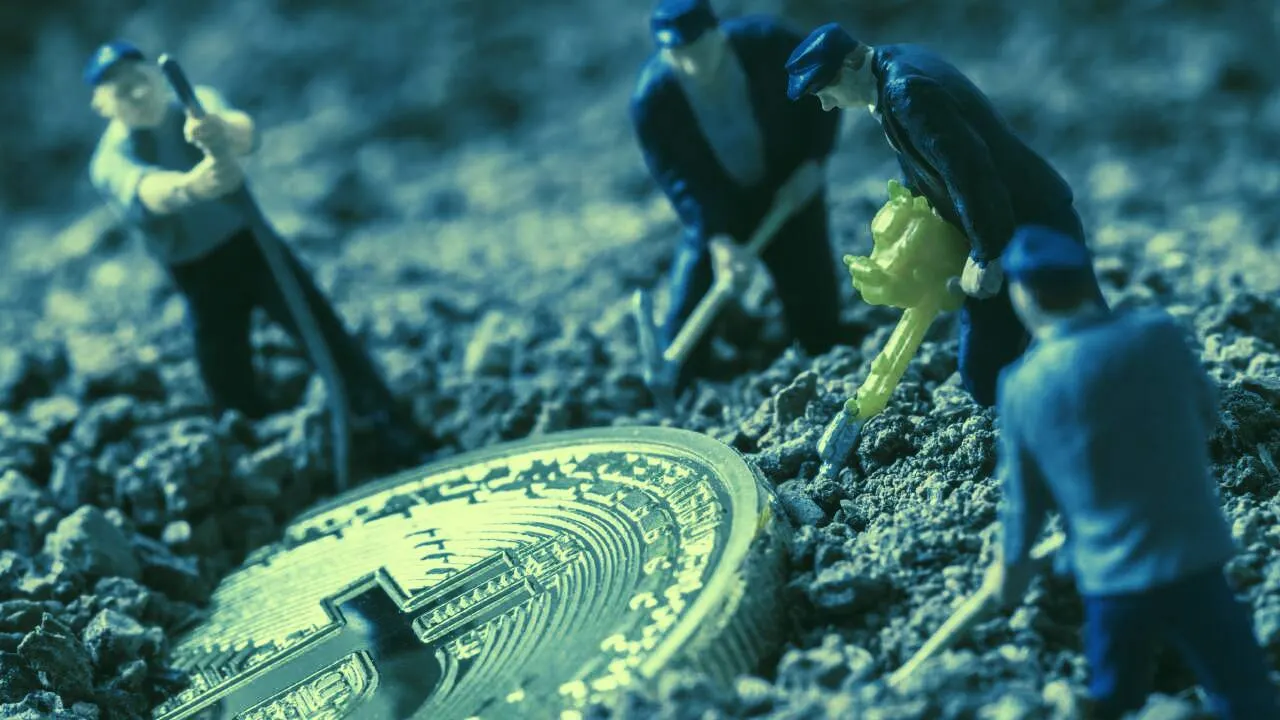In brief
- There is a hard cap of 21 million Bitcoin that can be mined, with the final coins being minted in around 2140.
- Once the circulating supply reaches its maximum, Bitcoin miners will no longer receive block rewards.
- They will instead be rewarded with transaction fees, assuming there are no major protocol changes to Bitcoin between now and then.
There will only ever be 21 million Bitcoins. That’s it. Once they’re all mined, which should occur in around 2140, no new Bitcoins will enter circulation.
The Bitcoin blockchain was designed around the principle of controlled supply, which means only a fixed number of newly minted Bitcoin can be mined each year until a total of 21 million coins have been minted.
Once all 21 million BTC have been mined, the network will largely operate the same as it does now, but with one crucial difference for miners.
Approximately every ten minutes, Bitcoin miners ‘discover’ a new block, solving a cryptographic puzzle that allows the successful miner to add the newly discovered block to the blockchain. Each block comprises a bundle of transaction records that were previously waiting in the Bitcoin memory pool, usually chosen based on the size of the transaction fee they provide to miners.
In return for discovering a block, the miner receives a fixed number of Bitcoins for their work, called the "block reward." When Bitcoin first launched, the reward was set at 50 BTC—but the reward halves every 210,000 new blocks, which ends up being roughly every four years.
Thus over time, the block reward has been cut to 25 BTC, 12.5 BTC, and 6.25 BTC. Three halvings have been completed so far; the most recent Bitcoin halving occurred in May 2020, cutting the block reward to 6.25 BTC. The next halving is expected to occur in 2024.
Bitcoin miners will be able to continue earning block rewards until a total of 21 million BTC has been minted, after which no new Bitcoin will enter circulation. Currently, just over 18.5 million BTC has been produced, equivalent to 88.3% of the maximum supply, minted in just over a decade. But it will take another 120 years before the last Bitcoin is minted, due to the gradual reduction of new Bitcoin creation caused by the halving process.
What will miners do when all the Bitcoin has been mined?
Once all 21 million Bitcoin have been minted, Bitcoin miners will still be able to participate in the block discovery process, but they won’t be incentivized in the form of a Bitcoin block reward. That’s not to say they won’t be rewarded at all, though.
As well as block rewards, Bitcoin miners also receive all the fees spent on the transactions included in each newly discovered block. Currently, transaction fees make up a small proportion of a miner’s revenues, since miners currently mint around 900 BTC (~$39.8 million) a day, but earn between 60 and 100 BTC ($2.6 million to $4.4 million) in transaction fees each day. That means transaction fees currently make up as little as 6.5% of a miner’s revenue—but in 2140, that’ll shoot up to 100%.
Losing the block reward won’t disincentivize miners, according to Simon Kim, CEO of VC fund #Hashed. “Changes to the Bitcoin ecosystem and its place as a key currency in the virtual world could drive significant changes in miner adoption even after the block rewards stop,” Kim told Decrypt.
Transaction fees broke their 2017 peak in April 2021
It’s true that switching to a reward structure based purely on transaction fees would almost certainly decimate the mining network now, since few Bitcoin miners would be able to profitably mine Bitcoin if they received just 6.5% of their typical rewards.
However, if the usage of the Bitcoin network were to explode, then competition for block space could increase dramatically. According to ByBit CEO Ben Zhou, that would likely lead to increased transaction fee rewards for miners—similar to what was seen during Bitcoin's 2017 bull run.
"As rewards for mining decrease upon each halving, and long before the last bitcoin is mined, transaction fees will play a more and more prominent role," said Zhou. "Transaction fees will likely grow in an inverse correlation to, and as a compensation for, the diminishing mining returns."
Moreover, Crypto.com COO Eric Anziani suspects that Bitcoin's price growth and gradually reducing energy costs could mean that mining will remain a profitable endeavor.
"In our view, as the adoption of Bitcoin and cryptocurrencies grows, its price should also increase considerably, which will more than make up for the lower rewards per block," he said. "Furthermore, as the mining process becomes more efficient and renewable energy becomes ubiquitous, miners’ electricity costs will fall, allowing them to stay in business and continue to secure the network.”
In December 2017—the transaction fee peak until mid-April 2021— the total transaction fees paid per day spiked to 1,495 BTC at a time when Bitcoin was valued at $14,000. As a result, miners earned a total of $21 million in transaction fees that day—which is currently around half of what they earn from the block reward today. The average cost of sending Bitcoin at the 2017 peak was $55.17. On April 21, 2021, that figure hit a new all-time high of $59.87. Just ten days before that, it was only $14.86; the average transaction fee had soared more than 300%. Put simply, this happened because the Bitcoin network was in demand. More people using the network typically means higher transaction fees.
Another possibility is that the reward mechanism for Bitcoin could change some time before the final block is mined. Luka Boškin, CMO of crypto trading platform NewsCrypto, argues that as the number of BTC produced by mining shrinks, Bitcoin will undergo “significant changes” to its protocol. “That could eventually include a switch to a more environmentally-friendly consensus mechanism like proof of stake or another successor to proof of work,” he told Decrypt.
This is a view shared by Niklas Nikolajsen, the founder of Swiss crypto broker Bitcoin Suisse. In an interview originally shot for German TV show Galileo, Nikolajsen was quoted as saying "I’m sure, once [proof of stake] technology is proven, that Bitcoin will adapt to it as well."
However, as of February 2021, work is not underway to bring proof of stake to Bitcoin, and there are no Bitcoin Improvement Proposals (BIPs) tabling the change either.
On the other hand, Skrill's head of crypto Jordan Stoev believes that the Bitcoin blockchain will likely be reserved for significant value transfers, and that layer 2 solutions or alternate blockchains will be used for the bulk of transfers. "Only transactions of very significant value will remain to be performed on-chain and they will pay very big transaction fees that will constitute the income to the miners," Stoev told Decrypt.
But there’s another potential outcome for Bitcoin. Since switching to a reward structure solely based on transaction fees would be a huge blow to miners—they would only earn just 6.5% of the rewards they earn today—what if Bitcoin miners stop mining Bitcoin altogether?
What happens if miners stop mining Bitcoin?
While there is a school of thought that suggests transaction fees will still sufficiently incentivize miners in the future, not everybody agrees.
Obviously, if a majority of miners—or even all miners—stopped mining Bitcoin, then the Bitcoin network would, in many ways, change forever. You would still be able to view which wallet addresses hold Bitcoin, and how much,, and you would also still be able to view the entire history of every single Bitcoin transaction ever made.
But confirming new transactions requires mining. If miners stop producing new blocks, it would effectively become impossible to spend any Bitcoin in the future.
That’s quite the doomsday warning for the Bitcoin network, but many believe miners will stay the course, even once transaction fees are their only reward. And as #Hashed CEO Simon Kim told Decrypt, there may be changes down the line that can incentivize miners even if block rewards stop, but not everybody agrees.
A 2016 Princeton University study concludes that transaction fees alone will not be sufficient incentive, and that relying on transaction fees alone will cause “troubling consequences” for Bitcoin’s future security.
The threat of the 'selfish miner'
The study cites “deviant” mining techniques that would undercut Bitcoin’s security. Of particular concern is the “selfish miner,” one who chooses not to release blocks immediately upon them being found, and instead withholds their blocks in the hope of tricking the network into wasting additional resources mining additional blocks that will never make it onto the blockchain.
That form of “selfish” mining, the study finds, “performs even better in the transaction-fee regime than in the block-reward regime” because with the current block-reward model, all blocks are worth the same, but in the transaction fees model, a selfish miner would earn more money by holding the block for longer. In other words, if transaction fees were the only incentive available to miners in the future, this kind of selfish miner would earn more for mining than a miner that worked for the good of the network.
The study admits there’s no a priori reason to be sure the selfish behavior would prevail, but bases its conclusion on “simulation results, along with some intuition and a theoretical analysis.”
Then there’s the concept of undercutting, which is where a deviant miner—let’s call him Alan—convinces another miner—we’ll call him Steve—to extend Alan’s own block, even if an older block of equivalent height was discovered earlier.
In a network that only rewards miners on transaction fees, Alan can convince Steve to extend Alan’s block’s direct predecessor and include slightly fewer transaction fees. If the level of unauthorized transaction fees are substantially fewer than those included in the other block, it would be in Steve’s interest to replace that block with a new block. This is what the study refers to as “undercutting.”
If undercutting became prevalent in the Bitcoin network—precisely because transaction fee incentives allowed it to become prevalent—then the dreaded “51% attack” on Bitcoin’s network suddenly becomes more feasible. Per the Princeton study, “In a blockchain with constant forks caused by undercutting, an attacker’s effective hash power is magnified because he will always mine to extend his own blocks whereas other miners are not unified. This would make a 51% attack possible with much less than 51% of the hash power.”
However, there’s a key caveat to the Princeton study that dampens the alarm around undercutting. At the time of the study, in 2016, it was correct to assume that blocks were only half full, and that miners had enough power to fork a block. Elias Strehle, CTO of CircularTree, a blockchain-powered ecosystem that allows organizations to share compliance information, told Decrypt that today it is “hard to imagine” blocks only being half full.
“Of course,” Strehle acknowledges, “the one argument still prevails: transaction fees might not be enough to give enough incentive for a secure hash rate for the network, which then increases the likelihood of a 51% attack.”
Not that anyone reading this piece right now will be alive in 2140 to see it.






